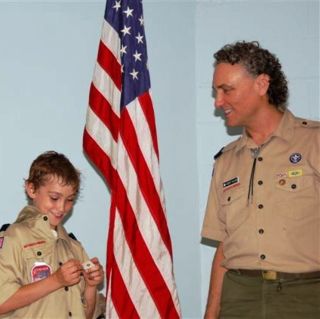Leadership
What I Learned About Leadership as an Adult in Cub Scouts
A Personal Perspective: I took over a dying Cub Scout Pack, hoping to revive it.
Posted February 13, 2023 Reviewed by Ekua Hagan

I was excited when my son became old enough to join Cub Scouts because I had enjoyed my scouting experience so much. I signed him up with the pack affiliated with our church and his school. There were 18 boys in the pack, 10 of whom were in the Tiger Cub den which was the beginning level at the time. The other eight boys filled out the four den levels above it.
Within a couple of months, the parents of the Tiger Cubs realized that we did not belong to an active Cub Scout pack; instead, it was a dying pack. On the contrary, the Tiger den was quite active because the den leader, who was an active-duty military man, had us follow the recommendations of the official Tiger Cub guidebook. I served as his assistant den leader.
The main pack, however, was doing little of the recommended activities, a fact that did not go unnoticed by the parents of the Tiger Cubs. There were no pack meetings or award ceremonies. Also missing were most of the games, contests, training courses, and other fun events that are associated with Cub Scouting.
We Needed More Leaders
The problem was a lack of leaders in the pack. There was only one: the pack Cubmaster. It was easy to see that he was completely overwhelmed. His intentions were good, but the responsibilities of running a pack were simply too many for one person; plus his job had him traveling out of town frequently.
He needed an Assistant Cubmaster who would take over as Cubmaster the following year. He was stuck with no replacement in sight. His son had one more year in Cub Scouts, at which point they would both move up to the Boy Scout troop. If no one replaced him, it could mean the end of the pack; a pack that had been chartered for more than 50 years.
Several parents were complaining, but no one was stepping up to help. I wasn’t happy either and considered our options. The easiest thing would be to move to a more active pack, but I wanted to commit to this one because its home was our church. So, I volunteered to be the Assistant Cubmaster. It was a sink-or-swim moment because the Cubmaster dumped nearly all of the responsibility onto my shoulders, and remained active mostly in an advisory role. The overwhelm shifted immediately to me.
I had no intention of doing all that work by myself, nor was I going to allow myself to get stuck in the position of Cubmaster with no successor. What I needed was more parent volunteers, but in order to get more parents, I had to recruit more boys into the pack first.
I Found a Magic Bullet
I consulted the Area Council and learned about a recruitment film that had been very successful. As soon as I watched it, I knew why. It showed Cub Scouts at camp doing many fun activities, but two stood out as the ones that would easily attract boys: shooting archery and BB guns.
In the first two weeks of the new school year, I got permission from all the nearby elementary schools to hold an assembly and show the recruitment video. Each boy who was interested was given a flyer with the date and location of the sign-up night. That video was magic; every single boy took home a flyer.
On the sign-up night, several parents came up to me saying, “My son emphatically told me that I had to bring him here tonight and sign him up for Cub Scouts.” We signed up 40 new boys that night.
Most parents were thinking they could just drop off their kid on Scout night and then pick him up two hours later. I had to change that thinking at our orientation meeting the next week. I needed at least one parent from each family to volunteer, but I didn’t want to frighten any of them away.
I Needed to Persuade Plenty of Parents
I opened the orientation meeting with a speech outlining my vision and mission. I had been speaking professionally for four years but was only beginning to give motivational talks. My goal was to paint a picture of all the fun activities and skills their sons would enjoy and learn over the next year.
Next, I explained we needed every parent to participate, but that I had a plan to minimize everyone’s involvement. My mission was to spread out the responsibilities so thin that it would not take much time, yet be enjoyable for all. In doing so, I was rewriting the official rules of Cub Scouts.
For example, the Boy Scouts of America recommends eight boys to a den with one leader and one assistant. I allowed up to 20 boys in a den with each parent committing to two weeks as den leader. All they had to do was plan the lessons and activities for those two weeks. I attended the first den meeting of each den and asked the parents to bring their calendars and commit to their two weeks.
I was determined that this Cub Scout pack would be the most fun for the kids and their parents with lots of learning opportunities for all. So, I created a committee for each activity the Cubs and their families would participate in throughout the year including the toy car and sailboat races, quarterly family camping trips (with one committee for each camping trip), and fundraising popcorn sales. I recruited two chairpersons for each committee and gave them the responsibility to recruit the parents they would need to fulfill their activity. I also initiated a monthly weekend day hike with one parent volunteer per hike to plan the location.
The Linchpin to My Organizational Plan
So that future Cubmasters would not get stuck in that position, I planned a line of succession encompassing three years: Assistant Cubmaster the first year to learn the ropes; Cubmaster the second year to recruit new scouts and committee chairs, follow up on committees, and run the monthly pack meeting; and year three, in a new position I created, Cubmaster Emeritus, which came with the responsibility of advising the Cubmaster and Committee Chairs as needed. It took me two years as Cubmaster before this program took hold.
I got people to volunteer by meeting with them privately and asking what they hoped Cub Scouting would mean for their child. I then described the various jobs for which the Cubs needed a leader, and finally, I asked them to choose and commit to one of them. I found that because I had minimized the responsibilities so well no one ever declined to help.
As the year went on, it was fascinating to see how many parents rose as leaders, and willingly increased their responsibilities. By my second year as Cubmaster, I had an Assistant Cubmaster and several more interested in the position. The pack was running smoothly like a well-oiled machine. I closed out my fifth year as Cubmaster Emeritus and moved up to Boy Scouts with my two sons. When I left, there were 68 boys in the pack.
I learned so much about leadership from working with volunteers. You can't boss them around because they will quit. You have to treat them with courtesy and respect. You must have empathy for their interests and desires, and you should encourage them to bring their strengths to the organization. When you do these things, you'll have joyful people willing to give their all.
Years later, I ran into some Cubs and their parents selling popcorn in front of a grocery store. They were wearing my pack number on their uniforms, so I stopped and chatted with the parents. They didn’t know me, but I told them I used to be Cubmaster and asked how many Cubs were in the pack. They replied, “200 boys.”
As I walked away, I swelled with pride, thinking, “Wow, 200 boys, that’s the legacy of my leadership.”




